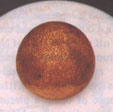Fossil orange update
A fossil orange? Or a broken piece of furniture? Ask almost anyone who has visited Harry Labudda’s museum and petrified rock garden in the town of Kingaroy in Queensland, Australia. They will tell you Harry has a fossil orange.

But some people can’t accept such a thing. ‘Someone came in the other day,’ Harry says, ‘and he tried to tell me it wasn’t an orange at all. He said it was just a piece that had broken off some furniture.’
Harry finds this difficult to accept. It’s hard for him to imagine someone making furniture from rock, and making it so clearly resemble a perfect petrified orange!
Dr John Osgood first brought Harry’s fossil orange to the attention of Creation magazine readers in December 1987. Since that time Harry’s ‘garden’ of rocks and petrified tree trunks, and his unusual little museum in Haly Street, Kingaroy, have featured favourably in major Australian newspapers, magazines, and television shows. In contrast, the orange was listed in a chapter of so-called ‘creationist hoaxes’ in a badly researched book by an Australian anti-creationist in 1990. The author had not examined or even seen the orange.
The controversy over this fossil orange has arisen because many people wrongly believe that the processes which cause petrifaction, coalification, opalization and other forms of fossilization must take millions of years. Yet as Dr Osgood pointed out in his article, ‘here is an orange from a place that has known the presence of oranges not much longer than a century.’
Harry says the orange was found in a creek at nearby Gayndah, which is known for its quality oranges and citrus fruit. Gayndah was founded in 1849. Its first oranges were sold in 1868 and the first commercial grove began operation only in 1896. This means that a fossil orange from Gayndah would almost certainly have had to form in less than 140 years—not millions of years!
Now three years after Dr Osgood’s article, I took a trip to Harry Labudda’s museum in Kingaroy with Creation magazine’s artist Steve Cardno, to get an update on the fossil orange.
Harry allowed us to hold the orange, poke at it, photograph, and video it. He doesn’t mind people examining it, but he won’t let them take it away. ‘I’ve been caught before when people take things away’, he says. His caution is understandable. But unless the orange is sectioned and examined, its authenticity will remain scientifically unverified.
Can it really be an orange? Or was that sceptic correct when he said it was a piece of furniture?
You’d have a hard time convincing all the visitors who have seen it that it is not an orange. It looks like an ordinary orange except for the faded colour, which varies from very pale orange at the top to almost dirty white on the bottom. It has an outer texture like an orange. It has an indented ‘navel’ like an orange. But it’s heavy and as hard as rock!
Someone has chipped a few small pieces out of one side, and poked at it with a blue-ink ballpoint pen to reveal the whitish rock under the surface. Someone once used an electric drill to bore a hole from the bottom to the centre, so they could see if it is solid inside. It is!
Harry is not a creationist. But he knows that at least some fossils have to form quickly. He has a rock slab which he says has ‘fossil’ raindrop indentations in it, and admits that such things have to form rapidly because raindrops don't sit around for millions of years.
Harry seems a bit surprised by all the fuss over his fossil orange. In fact he says this fossilized piece of fruit is not unique. ‘My wife had a petrified lemon many years ago’, he says.
They don’t know what became of the lemon, but Harry suggests that such things may not be as rare as many people think.


Readers’ comments
Comments are automatically closed 14 days after publication.